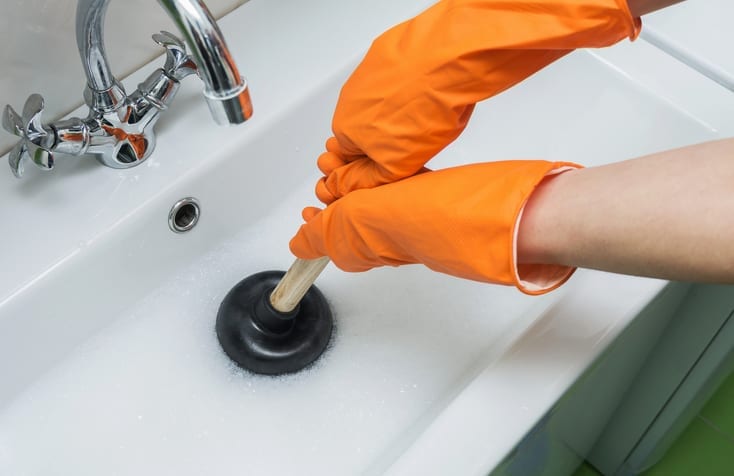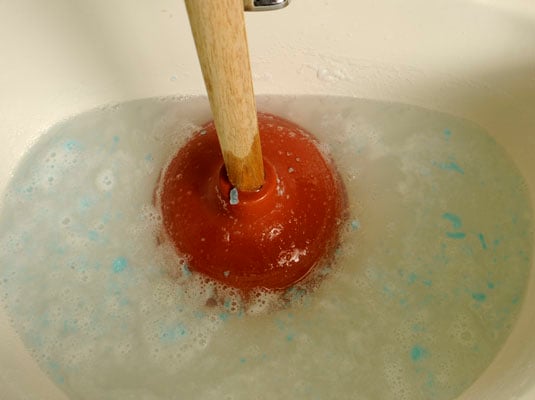Using Plunger and Drain Cleaner: Top Strategies
Using Plunger and Drain Cleaner: Top Strategies
Blog Article
On this page in the next paragraphs you will find a good deal of exceptional information about How to Use a Plunger to Unclog a Toilet or Drain.

Introduction
Correct upkeep of house drains is vital for preventing obstructions and guaranteeing smooth water circulation. One of the secret devices in every homeowner's toolkit is the plunger, along with various drain cleaners made to tackle stubborn obstructions effectively. This short article discovers just how to use plungers and drain cleaners successfully to maintain your drains pipes moving openly.
Area 1: Understanding Plungers
Types of Plungers
There are several types of bettors available, each created for various sorts of drains pipes and obstructs. One of the most typical kinds include cup bettors, flange bettors, and accordion plungers.
Exactly How Plungers Job
Plungers deal with the concept of developing pressure and suction to dislodge blockages. When appropriately used over a drainpipe, they develop a vacuum cleaner that can pull out debris or break up blockages.
Picking the Right Bettor
Selecting the appropriate bettor depends on the kind of drain and the nature of the blockage. Cup bettors are excellent for sinks and tubs, while flange bettors are better fit for toilets because of their style.
Usual Blunders with Bettors
Avoiding these mistakes guarantees efficient plunging: improper seal around the drainpipe, inadequate force, and unclear surrounding particles.
Section 2: Making Use Of Plungers Successfully
Preparation
Prior to plunging, make certain the plunger covers the drainpipe completely and creates a tight seal. Clear any type of noticeable debris around the drainpipe opening.
Technique
Begin with mild plunging movements to construct suction. Increase stress progressively, using a consistent rhythm. Repeat as essential until the drain gets rid of.
Repairing Tips
If plunging doesn't work, attempt readjusting the seal, using petroleum jelly for a far better seal, or using a different type of plunger.
Section 3: Comprehending Drainpipe Cleaning Company
Sorts Of Drainpipe Cleaning Company
Drain pipes cleansers can be chemical or chemical. Chemical cleansers utilize solid chemicals to dissolve blockages, while enzymatic cleaners utilize all-natural enzymes to break down raw material.
How Drainpipe Cleansers Work
Chemical cleaners respond with obstructions to liquify them, while enzymatic cleansers break down natural products like hair and grease without harming pipes.
Safety Considerations
Always wear handwear covers and eye defense when making use of chemical drainpipe cleaners. Make sure appropriate ventilation and follow manufacturer guidelines meticulously.
Eco-Friendly Alternatives
Take into consideration utilizing vinegar and baking soft drink or enzyme-based cleaners for environmentally friendly options that are much safer for pipes and the setting.
Section 4: Making Use Of Drain Cleaning Company Efficiently
Application Strategies
Pour chemical cleansers directly right into the drainpipe opening. Allow them to benefit the recommended time before purging with hot water. Enzymatic cleansers need to rest overnight.
Precautions
Prevent mixing various sorts of cleansers, as this can generate poisonous fumes. Never ever use chemical cleaners along with a plunger, as splashing can happen.
Dealing With Stubborn Clogs
For persistent clogs, consider making use of a pipes serpent or calling a specialist plumbing professional to stop damages to pipes.
Verdict
Finally, recognizing just how to utilize plungers and drainpipe cleaners efficiently is crucial for keeping healthy plumbing systems. By choosing the right tools and strategies, house owners can tackle minor obstructions and stop significant plumbing issues down the line.
How To Properly Use A Plumbing Snake To Clear Drains
When any drain clogs in our home arise, we tend to gravitate toward the plunger and little else. In cases where the plunger and its vacuum-created pressure are not able to clear clogs, many immediately move to harmful chemicals or simply call their plumber to fix the issue.
we’re happy to help with all drain cleaning needs and concerns. This includes informing you on a few other home remedies you may have at your disposal for minor to moderate clogs, one of which is the use of a plumbing snake. Many people have never used one of these before – let’s go over the steps to take when your drain clogs and you have a plumbing snake available.
Attempt Plunger Use
The first step here, as we noted above, should indeed be to grab your plunger when you notice a drain clog and attempt to resolve it this way. If you’re unsure how to use a particular type of plunger, our plumbers can answer any questions you have. If this doesn’t do the trick, however, you move on to the snake.
Locate And Prepare Snake
A plumbing snake is a metal or plastic device that’s generally about a quarter of an inch thick. It’s design with significant extensions, meant to reach down into your clogged drain and push the clog out. Snakes also contain drain augers that will latch onto and push stubborn blockages.
If your plunger doesn’t clear a clog, locate your snake and bring it to the drain in question. We also recommend keeping a bucket nearby to collect the clog once you pull it out, plus we’d advise wearing goggles and possibly protective gloves.
Feed Snake
Once you’re ready to go, feed the snake slowly down the drain, using the crank device it comes with to keep it moving until it finds the clog. Once this happens, much of the clog will be latched onto the coil so you can pull it out, while the rest will simply break up and flow downward.
Detach Debris
Remove the snake slowly from the drain, and once you’ve done so, pick off any debris that’s stuck to the coil. This is another area where wearing gloves is a must.
Flush Drain
Finally, take a few minutes to ensure the snake has done its job correctly. If you’ve been using it on a toilet, flush the toilet a couple times and make sure everything flows well. If you’ve used it on a different drain, flush it with some room temperature water.
https://www.mybuddytheplumber.com/blog/how-to-properly-use-a-plumbing-snake-to-clear-drains/

Application Strategies
Pour chemical cleansers directly right into the drainpipe opening. Allow them to benefit the recommended time before purging with hot water. Enzymatic cleansers need to rest overnight.
Precautions
Prevent mixing various sorts of cleansers, as this can generate poisonous fumes. Never ever use chemical cleaners along with a plunger, as splashing can happen.
Dealing With Stubborn Clogs
For persistent clogs, consider making use of a pipes serpent or calling a specialist plumbing professional to stop damages to pipes.
Verdict
Finally, recognizing just how to utilize plungers and drainpipe cleaners efficiently is crucial for keeping healthy plumbing systems. By choosing the right tools and strategies, house owners can tackle minor obstructions and stop significant plumbing issues down the line.
How To Properly Use A Plumbing Snake To Clear Drains
When any drain clogs in our home arise, we tend to gravitate toward the plunger and little else. In cases where the plunger and its vacuum-created pressure are not able to clear clogs, many immediately move to harmful chemicals or simply call their plumber to fix the issue.
we’re happy to help with all drain cleaning needs and concerns. This includes informing you on a few other home remedies you may have at your disposal for minor to moderate clogs, one of which is the use of a plumbing snake. Many people have never used one of these before – let’s go over the steps to take when your drain clogs and you have a plumbing snake available.
Attempt Plunger Use
The first step here, as we noted above, should indeed be to grab your plunger when you notice a drain clog and attempt to resolve it this way. If you’re unsure how to use a particular type of plunger, our plumbers can answer any questions you have. If this doesn’t do the trick, however, you move on to the snake.
Locate And Prepare Snake
A plumbing snake is a metal or plastic device that’s generally about a quarter of an inch thick. It’s design with significant extensions, meant to reach down into your clogged drain and push the clog out. Snakes also contain drain augers that will latch onto and push stubborn blockages.
If your plunger doesn’t clear a clog, locate your snake and bring it to the drain in question. We also recommend keeping a bucket nearby to collect the clog once you pull it out, plus we’d advise wearing goggles and possibly protective gloves.
Feed Snake
Once you’re ready to go, feed the snake slowly down the drain, using the crank device it comes with to keep it moving until it finds the clog. Once this happens, much of the clog will be latched onto the coil so you can pull it out, while the rest will simply break up and flow downward.
Detach Debris
Remove the snake slowly from the drain, and once you’ve done so, pick off any debris that’s stuck to the coil. This is another area where wearing gloves is a must.
Flush Drain
Finally, take a few minutes to ensure the snake has done its job correctly. If you’ve been using it on a toilet, flush the toilet a couple times and make sure everything flows well. If you’ve used it on a different drain, flush it with some room temperature water.
https://www.mybuddytheplumber.com/blog/how-to-properly-use-a-plumbing-snake-to-clear-drains/

Do you appreciate reading up on How to Use a Plunger to Unclog a Toilet or Drain? Place a comment down the page. We would be delighted to hear your insights about this write-up. Hoping to see you back again before long. Sharing is nice. Helping people is fun. We truly appreciate your readership.
Get Offer Report this page